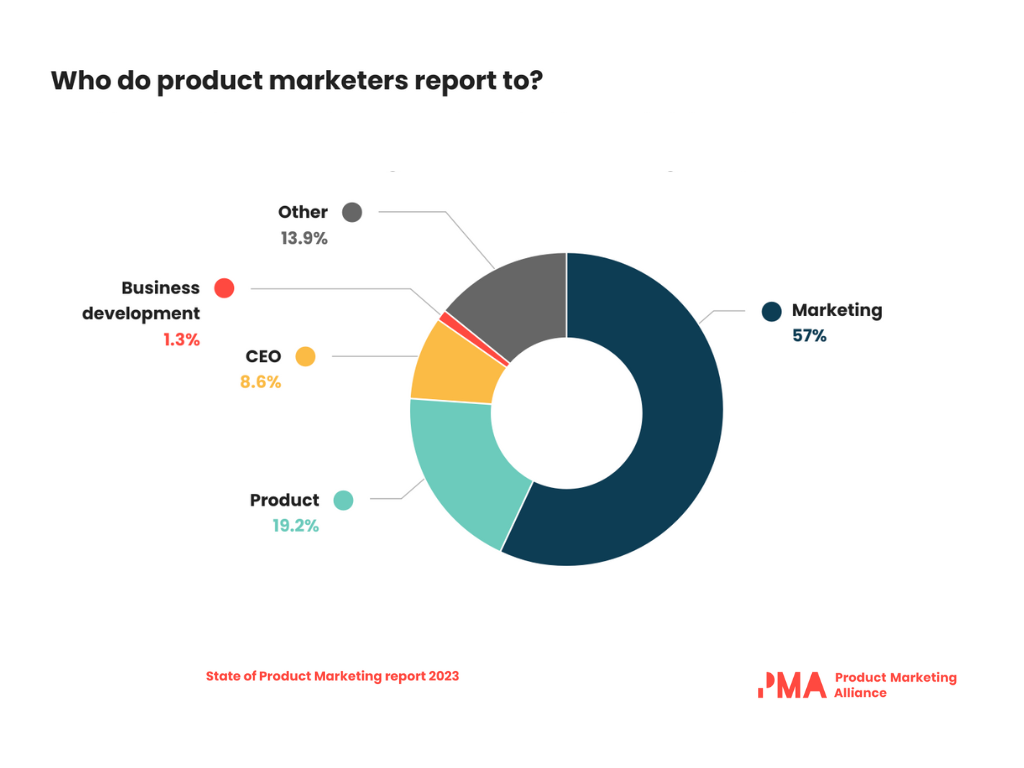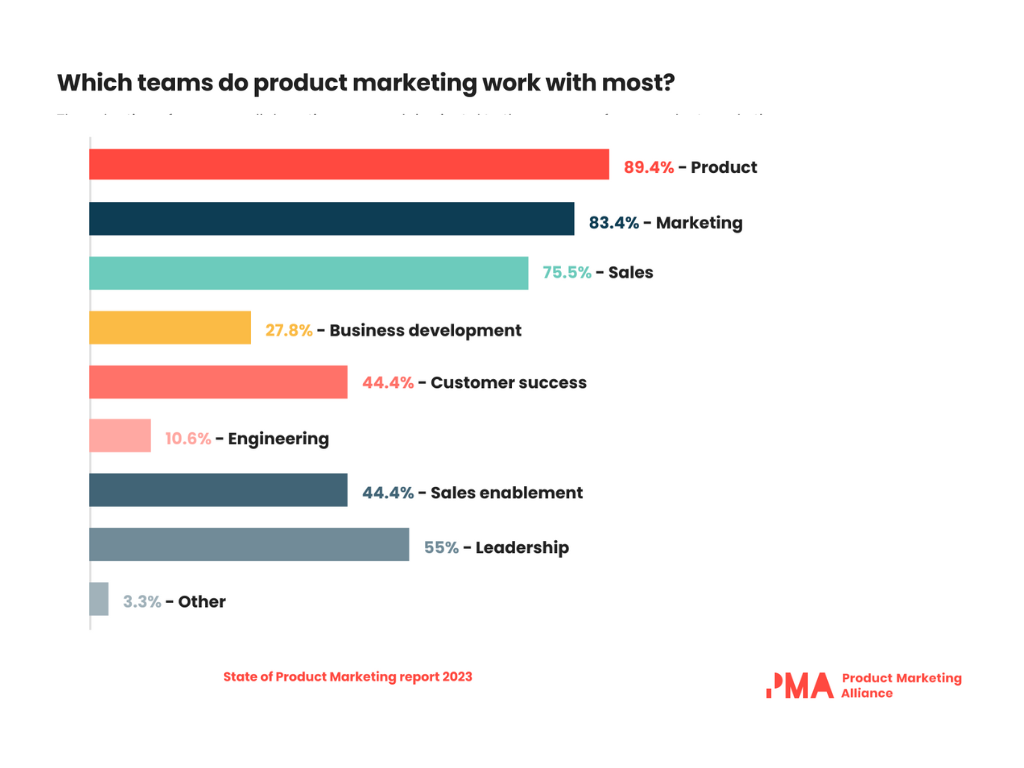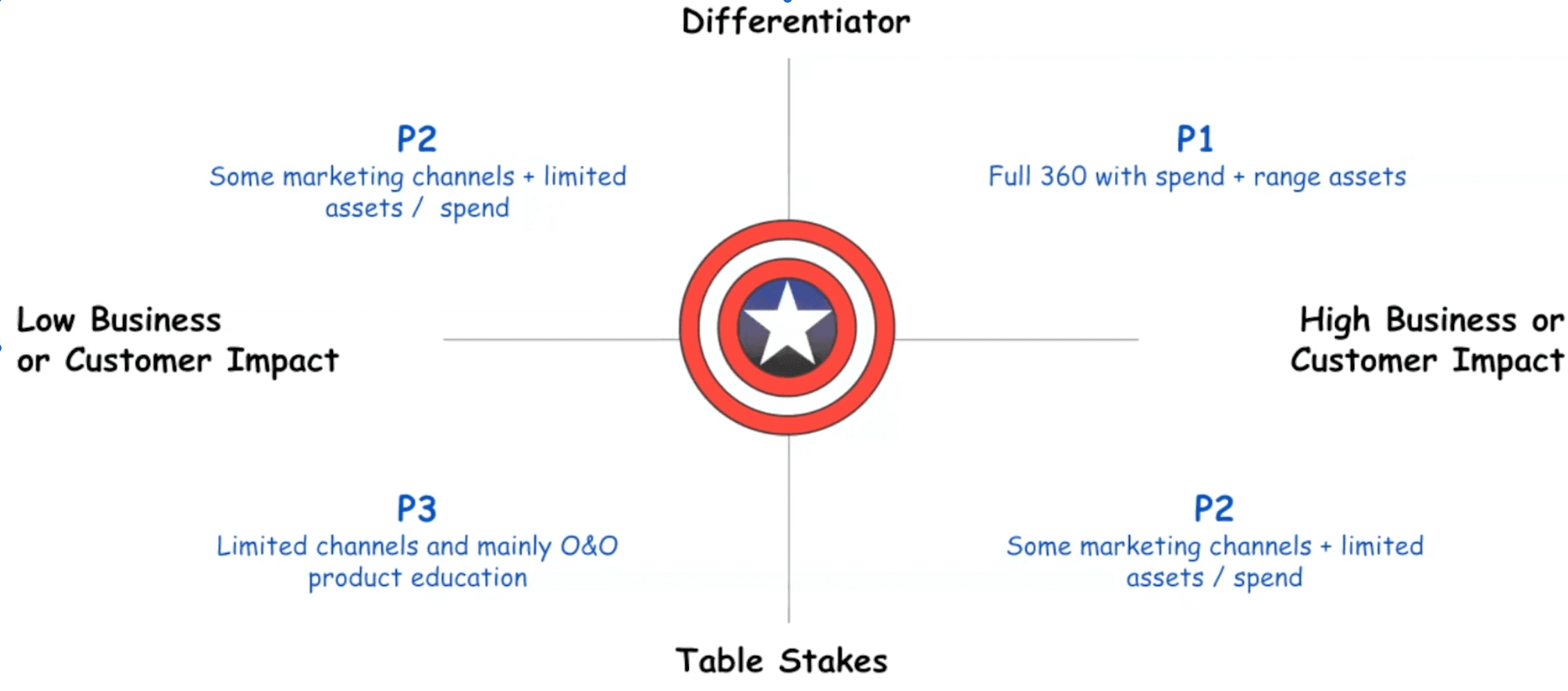The lifeblood of your business is bringing value to customers. If you're looking to increase sales, improve customer service or create better brand awareness, then you need to find ways to get people talking about your products and services. This accounts for a large portion of a product marketer’s role.
Product marketing is a fairly recent development within the business world. So, many people are yet to grasp the role, and where it fits within the company structure.
In this article, we will explore:
- What a typical business structure looks like
- Where product marketing fits into a traditional business structure
- Benefits of product marketing teams
- How to optimize your product marketing team
- Product marketing challenges and how to overcome them
How are businesses structured?
Business structure varies depending on the size and type of the organization.
Within the ‘typical’ structure, there’s often a management hierarchy in place, comprising a CEO who sets the direction and vision for the company, supported by an executive team that helps implement those plans.
Add to that, there's a board of directors (sales, marketing, customer success, etc.) that provides oversight and guidance.
Where does product marketing fit into a traditional business structure?
Product marketing is a department that sits at one of the top levels of the business structure. You will typically have a Head of Product Marketing, who will sit within the board of directors and work closely with the CEO/COO. Then, a Product Marketing Manager (or PMM) will oversee a team of product marketers to successfully meet their goals.
The primary goal of product marketing is to create new products or features for existing products. This includes finding ways to increase revenue, reduce costs, and increase customer satisfaction. PMMs work closely with sales, marketing, and customer success teams to ensure the company’s products meet customers' needs.
In the 2023 State of Product Marketing report, we asked PMMs to state who they report to within the business.

The results showed that over half of PMMs sit within the wider marketing function, with a further fifth reporting into Product.
We also asked how often PMMs collaborate with different departments. Unsurprisingly, 9 in 10 product marketers work closely with Product, and a similar number maintain close ties with Marketing. These results only further enforce this idea that internal collaboration is an intrinsic part of the product marketing process.

When asked where product marketing sits within her organization’s structure, Courtney Bain, Senior Product Marketing Manager at Cashrewards, explained:
“I’m in an org with both B2B and B2C. I’m currently the Head of B2C Marketing as that's the higher priority audience for us, but I’m already in discussions with my manager and GM of Product where I best sit longer term. I'm their first PMM hire.”
Courtney’s experience shows that businesses are still only now hiring product marketers into their companies. And yet, our CEO and Founder Richard King says:
“There’s no doubt in my mind that product marketing should be the first marketing hire. PMMs aren’t nice-to-haves, or an extra layer to add to the department down the line, they need to be the foundation of the product and marketing team’s growth plans because they’re the ones advocating your customers and ensuring company outputs are in line with market needs.”
problem-solving
Why are product marketing teams useful?
Before you achieve and surpass your business goals, you need to understand your target personas. The good news? There are a whole bunch of customer and market research tools you can use to support you with the process.
Once you’ve established your customer needs, you can create a product or service that ticks the boxes and that’s truly valuable for them, and at the same time, valuable for you. After all, if you create a product your customers don’t want or need, they’ll seek an alternative elsewhere.
There are many ways in which PMMs use their specific skill set to improve the business:
Strong communication
Effective internal communication requires understanding the project from both sides. The manager should know the product roadmap, how long each feature takes, and what problems the team needs to solve. Similarly, a developer should know how much work they have done, how much is left, and what problems remain unsolved. This will enable both parties to understand the current state of the project.
Collaboration with coworkers
Collaboration skills help you to be able to build relationships, collaborate on projects, and share information. The key to successful collaboration is to understand the needs of others and find ways to meet them. This requires you to know what other people want, how they feel about things, and what motivates them.
Knowing all of these things will make the process of creating and launching a product that much easier and using specialized collaboration tools can help you work in sync with your colleagues and optimize performance.
Creativity and problem-solving
Creativity helps PMMs to think outside the box, solve problems, and create innovative solutions for new opportunities. These skills are essential to rise above competing products.
Empathy and ability to connect with customers
Customer skills are important for the successful running of any business. They allow us to understand our customers' needs better, which makes them feel valued and appreciated. The best way to improve customer skills is to ask questions, listen carefully, and keep an open mind.
This will improve your business as customer engagement leads to sales.
Research and analytical skills
Research skills help PMMs understand what customers want and how to fulfill their needs. It can be difficult to know where to start when trying to establish these requirements, but you need to figure out why people buy from you, and what makes you different from other businesses. Once you learn these things, you can then find ways to innovate and create new product ideas.
Content creation and copywriting
Well-crafted copy attracts customers and builds relationships. Writing skills can be used to market yourself, your product, or your service. A good copywriter can help you create effective ads or brochures, and can also help you create a compelling website.
How to optimize your product marketing team
There are many ways in which product marketers can utilize their skills to excel within their company. As product marketing straddles all these different departments, it would be easy for them to use different strategies and tactics to help other departments improve their processes.
We have put together a few ways in which you can further develop the product marketing skills that you already have, and boost them into benefitting the entire company.
Prioritize your products
The most impact that a product marketer can make is to ensure all projects are done on time and under budget. This includes working well with team members, understanding how to communicate clearly up the chain of command, and managing expectations.
A product marketer should also be able to handle changes in scope, prioritize tasks, and help staff understand what they need to do to complete a project successfully.
Creating a model to prioritize your products will help to balance all the products you need to market. Marie Le, VP of Marketing at MoneyLion gave an insight into her prioritization framework, saying PMMs should use this format to “ruthlessly prioritize and also get alignment with your stakeholders on the level of support any given product or launch gets.”
Product marketers at MoneyLion use the following framework to start mapping out where certain features go and label them on where they fit within their priorities. This means looking to see if new features are differentiators or table stake features, and simultaneously, if they fit as a low or high business or customer impact.

P1: Full 360 with spend and range assets
- This is where a product is a differentiator and also has a massive business or customer impact.
- Also, if it is a full 360 launch, activating every single marketing channel there is, and if it gets a lot of spend and range of assets.
P2: Some marketing channels and limited assets/spend
- If it is a differentiator and has a low business impact,
- Or, if it has high business impact and table stakes.
- These are where the product gets some, but not a lot, of “marketing love”, like limited assets and spending to support the product launch.
P3: Limited channels and mainly owned and operated product education
- Has both table stakes and low business/customer impact
Use your research to boost your products
Market research is completed by PMMs to find out what works best for their customers, and then use that information to create new offerings; it’s one of the most effective ways to increase sales.
Neglecting research can lead to bad decisions for your company. A lot of businesses today rely on data analytics tools such as Google Analytics to gather information about customer behavior, so becoming familiar with how to use these is crucial. Which brings us to our next tactic...
Become technology-friendly
To improve performance within your business, you need to familiarize yourself with new technologies, understand how they work, and establish how to apply them within your setup.
Technology has changed the way we work, with the emergence of platforms such as Skype, Zoom, and Microsoft teams. Similarly, with more teams working remotely, project management tools such as Asana, Basecamp, Trello, Jira, and others, are being implemented to help internal teams stay organized and keep track of progress.
Embrace social media platforms
Amazingly, there are still many companies reluctant to acknowledge the benefits of a social media presence. However, according to the Statista Research Department, there were over 3.6. billion people worldwide were using some form of social media in 2020, a number that’s set to increase to 4.4 billion by 2025.
With internet use expanding every year, modernizing your sales content will only help to bring a large target audience. Using social media will reach more people in a smaller amount of time, widening profit margins and product engagement.
Social apps such as Facebook, Instagram, Twitter, and TikTok are bringing in millions of views, comments, and shares every single day. Consistently using these platforms to promote your products will only bring your business more attention and more sales.
Algorithms = Views= Engagement = Sales
Invest time into learning about how to engage and interact with an audience online, and watch your business expand.
Common challenges in product marketing
If you want to be successful in any industry, you need to know how to deal with challenges. As a product marketer, you need to understand what makes a product successful, and how you can contribute to the overall process. When faced with multiple projects at once, you need to work together as a team to help each other succeed.
There are a few challenges PMMs may encounter when working within a business that could be avoided by applying certain strategies.
Getting a seat at the table
Product marketers are still trying to establish themselves as a valuable and influential part of the business structure.
Nicole New, Head of Product Marketing at Trainline, agreed that the biggest challenge in her role is “having to fight for the function to be put in place, and then continue to fight to keep it there despite everyone day-to-day sharing feedback that it's vital to their work.”
Become more valuable to the organization by understanding how you can contribute to the business objectives of the company. Managers need to know what their responsibilities are, and how they fit into the organization’s goals. They also need to be prepared to communicate those ideas clearly and to work well with others.
Another important step is to advocate for your role and use your specific skill set to fight for your product and show why you should have a seat at the table.
The best way to do this is to engage with others about what you do, to gain insight into other areas of the business that may need attention. This helps you understand how you fit into the bigger picture, and can help you identify ways to contribute to the growth of the business, whilst also showing them just how much of an asset you are to the business.
Lawrence Chapman, Copywriter at PMA, gives us an incredibly detailed insight into how the C-Suite perceives product marketing. This is a resource that you can leverage to understand how your employers view you and how you can influence these perceptions to get a seat at the table within your organization.

Being misunderstood/undervalued
In the 2021 State of Product Marketing report, only 4% of PMMs felt that their colleagues truly understood the role they play within their organization. And, they felt as though, on average, their role was valued at around 6.9/10.
Agnes Eswono, Product Marketing Manager at IR, said:
“The company I used to work at was a large multinational. I was a product manager there. Product marketing was viewed more as 'strategic marketing' and quite well respected, whereas marketing was the day-to-day print brochures, ‘making things pretty’ sort of role.
“I'm at a smaller global company now as a PMM. Product managers view PMM as a strategic go-to-market with a launch focus, whereas the marketing team views us as 'part of marketing, but focus only on the product/portfolio'. The rest of the company just sees PMM as marketing, even though it's in the Product team. I'm trying to shift the perception so that they view product marketing as a strategic function, much like product managers.”
Increase your value to your employer and internal teams by asking for feedback, showing initiative, and working harder than others. Make your voice as a product marketer heard, and ensure everyone at your company understands your role.
Your employer wants to know how much effort you are putting into the job, and what you plan to do next. If you want to create a positive environment, ask your boss about his/her career goals. This will help everyone understand the bigger picture and the possibilities for both parties.
Strike a healthy work/life balance
A big challenge for most PMs is learning how to balance work and personal life.
Lisa Edwards, Senior Product Marketing Manager at HubSpot, echoed this statement, explaining:
“I think this might be common for folks in other companies but burnout is the biggest challenge I face in product marketing. There's a never-ending list of things to do. And when you are a strategic leader on something, it's really hard to say no. Because if it needs to happen as part of the launch and it's not anyone else's job, then you just kind of buck up and do it yourself.”
“A way to tackle this is to ensure you are prioritizing the most important pieces of work first. Also, learn when to say ‘no’, or delegate that which you can’t turn down. Don’t forget that you are human. Though your career is important, you need to remember that you have a life outside of work that you must tend to.”
How to improve team skills
The perfect way to ensure product marketers are given a seat at the table is to consistently advocate for your role and educate others on what you do. The best way to do this is to know your role inside and out.
Add credibility to the PMM function by taking the Product Marketing Core: Certification. Even better, get your whole team certified with you! The Product Marketing Core (PMMC) will arm your team with all the tools and knowledge they need to revolutionize your company’s product marketing efforts.
Don’t just take our word for it. Megan Liken, Product Marketing Specialist at cPanel said:
"This certification program has been extremely validating for the team and has shifted our perspective on how we work.
“The course has helped all of us start speaking the same language, rally around the same goals, and has assisted in standardizing some of our processes. What's exciting is we have begun receiving buy-in from the rest of the company and collaboration with the Product teams is becoming more seamless!"
Sign up now and get your team on the course with discounted rates.


















 Follow us on LinkedIn
Follow us on LinkedIn




.svg?v=1461f28f41)